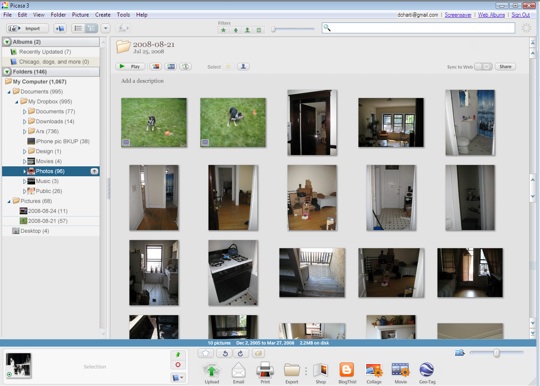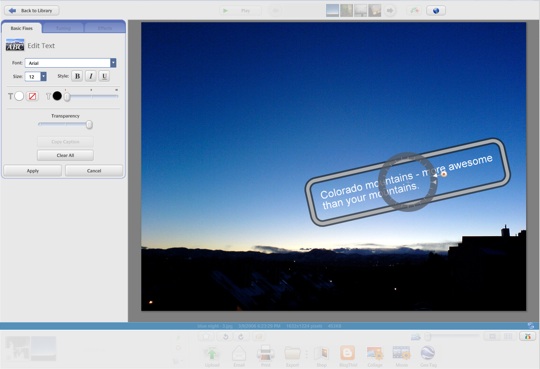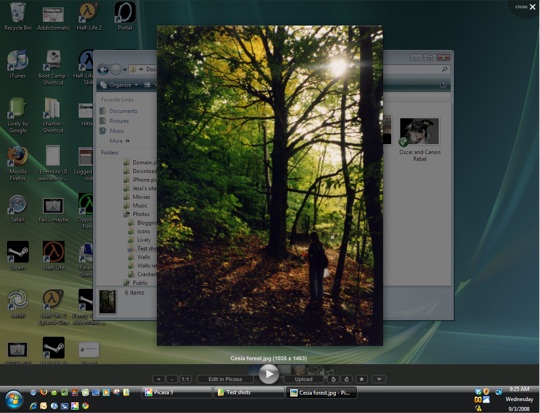Google announced major updates yesterday to both components of its Picasa ecosystem: its desktop client and Web Albums, a service for displaying and sharing photos online. Ars Technica took some time to dust off the old family photos to see what the new editing, publishing, and identifying features are all about.
Google's Picasa announcement is two-fold, involving a desktop client and web service that are now much more closely integrated, so we'll try to cover them separately while pointing out the new ways in which they shake hands. Since Picasa hinges in many ways on its desktop client, though, we'll start there.
Picasa 3 for your Windows PC (make a Mac OS X client please)
Sporting a much more refined overall UI, Picasa 3's new features and publishing integration are easily worth more than 1,000 words (but that's about where we'll get in this piece). Unfortunately, Picasa 3 is only available for Windows right now, with the Linux version still at 2.7 and a Mac version only rumored to be on its way before 2008 is over. Picasa's UI is tighter, with smaller buttons in some areas like its top toolbar, and it even adopts new UI tools like the button slider from the iPhone OS for toggling features like syncing an album or folder to Picasa Web Albums (more on that in a minute). We haven't been heavy users of Picasa in the past, but the changes are definitely welcome and make the app feel more mature.

Probably the most significant new feature in Picasa 3 is a new "Sync to Web" switch that adorns any folder or album. As you can imagine, this allows any new photos, or even changes made to existing photos, to be automatically synchronized up to Picasa Web Albums (a free Google Account is required), Google's Flickr competitor. This new feature by itself transforms Picasa and its web counterpart into a much more appealing solution for organizing and sharing photos, as it takes the complicated busywork out of publishing photos online. It also removes the need to find, install, and maintain some sort of third-party uploading tool, which is often the case with similar online services like Flickr, Photobucket, and SmugMug.
In our testing with adding new photos to a folder and making edits using various new tools (again, more in a moment), Picasa 3's automatic sync feature worked really well and kicked in immediately after every change we made. We did not, however, perform any heavy lifting, such as dumping a couple hundred photos from a shoot or vacation into a shared folder. Let us know what your experience was like if you're doing work like this.

Next on Picasa 3's notable new features list is an enhanced set of editing tools. Users now have more tools for cropping, correcting color and contrast, fixing red-eye, retouching, adding text, and more. Naturally, these tools are accompanied by changes to Picasa's fixes and effects panels, and they offer a fairly well-rounded set of features as far as free image organization tools go.

A unique new feature that Picasa 3 presents to users with a first-run wizard is the ability to take over Windows Explorer's duties as an image viewer. A handful of basic supported image formats are checked by default, including .JPG, .RAW, .TIF, and .BMP, and Google added some special sauce to the actual viewer if you opt to use it. Double-clicking an image in Windows Explorer will evoke a dimming overlay over the desktop and any open applications, displaying a border-less full version of the photo with a slick scaling animation. A media strip sits below, just above the Windows task bar, containing thumbnails of other images in the folder and basic navigation controls.
The effect is nice (though arguably unnecessary) and reminiscent of various "Lightbox" JavaScript image packages you may have seen on some websites and blogs. Picasa's image viewer doesn't seem to take any longer to load when compared to Vista's default of Windows Photo Gallery, and usually seemed to be a bit snappier in our testing.
Last but not least in Picasa 3's repertoire of new tricks is a basic movie maker with YouTube integration. Users can group a selection of photos into a simple movie, pick from a handful of transitions and resolutions (all the way up to 1080p), add text slides, and apply an audio track. Besides one-click publishing to YouTube there isn't much to get our shutters out of sync over, but it's still nice to have features that are sure to make mom and the family happy come holiday season.
Picasa Web Albums does face recognition
With Picasa 3 out of the way, we gave some of Picasa Web Album's new features a run-through to find that they compliment its desktop brethren's experience pretty well, if not awkwardly at times. Easily the most impressive new feature is "Name Tags," which harnesses facial recognition technology to automatically identify people in photos. This makes it easy to, say, keep a running album automatically updated with photos of Cousin Erin or your parents, but this all has to be done on Picasa Web Albums. Picasa 3 does none of this work on the desktop, and doesn't appear to gain any of the advantages of all this automation and facial recognition tagging.

That said, Google's facial tagging technology was pretty impressive in our testing, as it did reasonable well when picking the same individual out of a group of photos shot at different events and even in different lighting. It wasn't perfect every time, of course, but Google built in features like buttons for commonly tagged names and, naturally, integration with one's Gmail contact list for quickly picking names out of the crowd. Google certainly isn't the first to offer facial recognition in a web service like this (Facebook has offered a much more basic set of similar features for some time now), but this is definitely one of the best implementations we've seen.
If you want to give this "name tags" feature a try, be sure to switch it on in your Picasa Web Albums Settings area; it isn't enabled by default yet.
Another significant feature of Picasa Web Albums for anyone halfway serious abut their photography is the integration of Creative Commons licensing. A default CC license can be set in the Settings area to allow remixing, allow commercial use, and require share-alike terms, or users can, of course, opt to not allow any of these options. This license can also be customized for each photo in the sidebar.
Picasa Web Albums has received lots of other refinements, in addition to a refreshed UI of its own. Last on our mentionable list for now is a new Explore page that allows visitors to sift through Picasa's public library and a hand-picked selection of prime photography. Popular tags are a welcome touch, though it would've been nice to see geolocation tools offered here for an even more interesting experience.
Worth more than 1,000 words
Ok fine, so we went over our initial word budget, but this major Picasa update deserved it. Google has been squandering some unique potential in the photo sharing space for a while now with these two separate components, and it's great to see its offline photo organization tool integrating the way it should with an online publishing and sharing service. Flickr probably doesn't haven't anything to worry about just yet, but we wouldn't be surprised to see a new batch of users giving the convenient new Picasa ecosystem a try.
reader comments